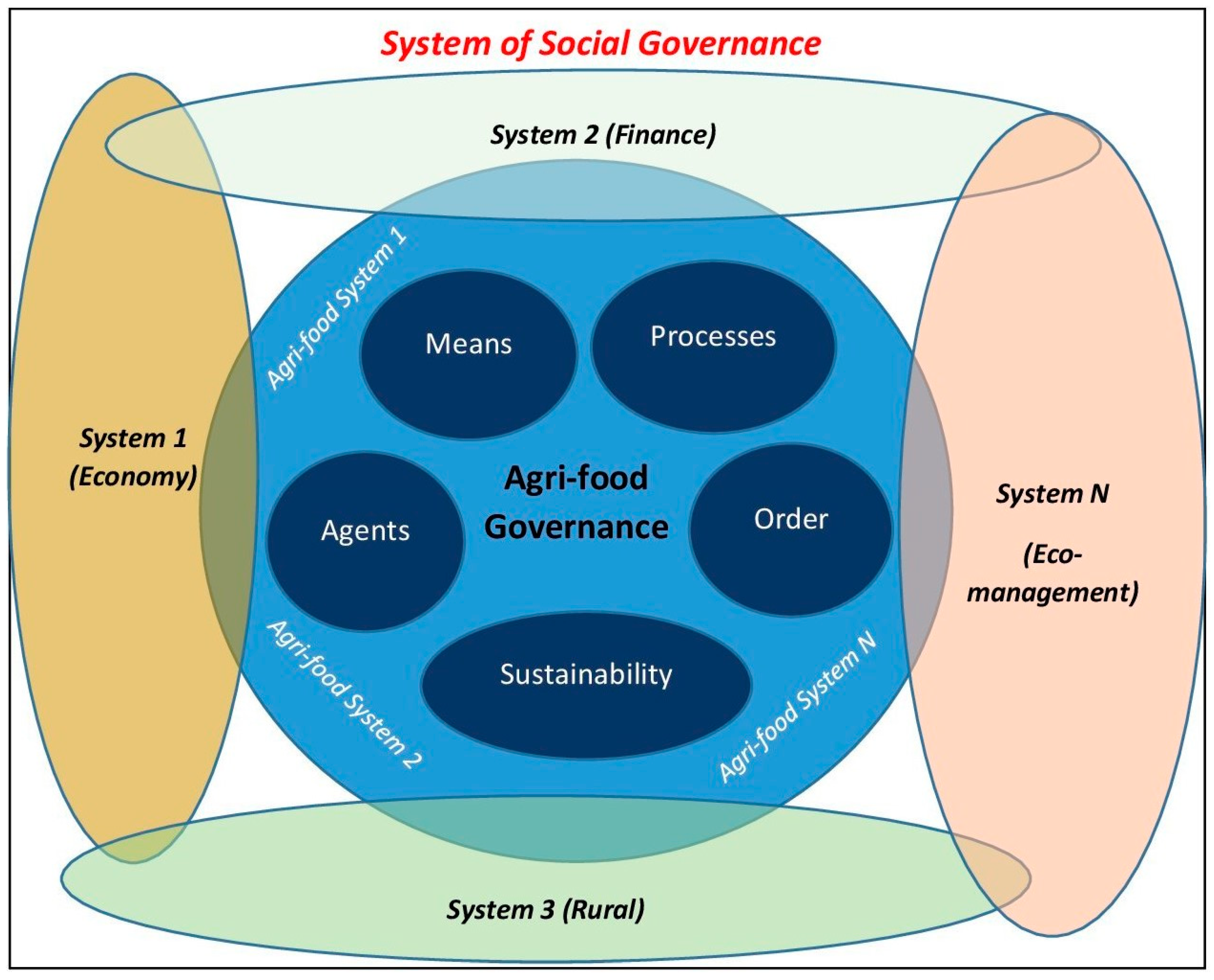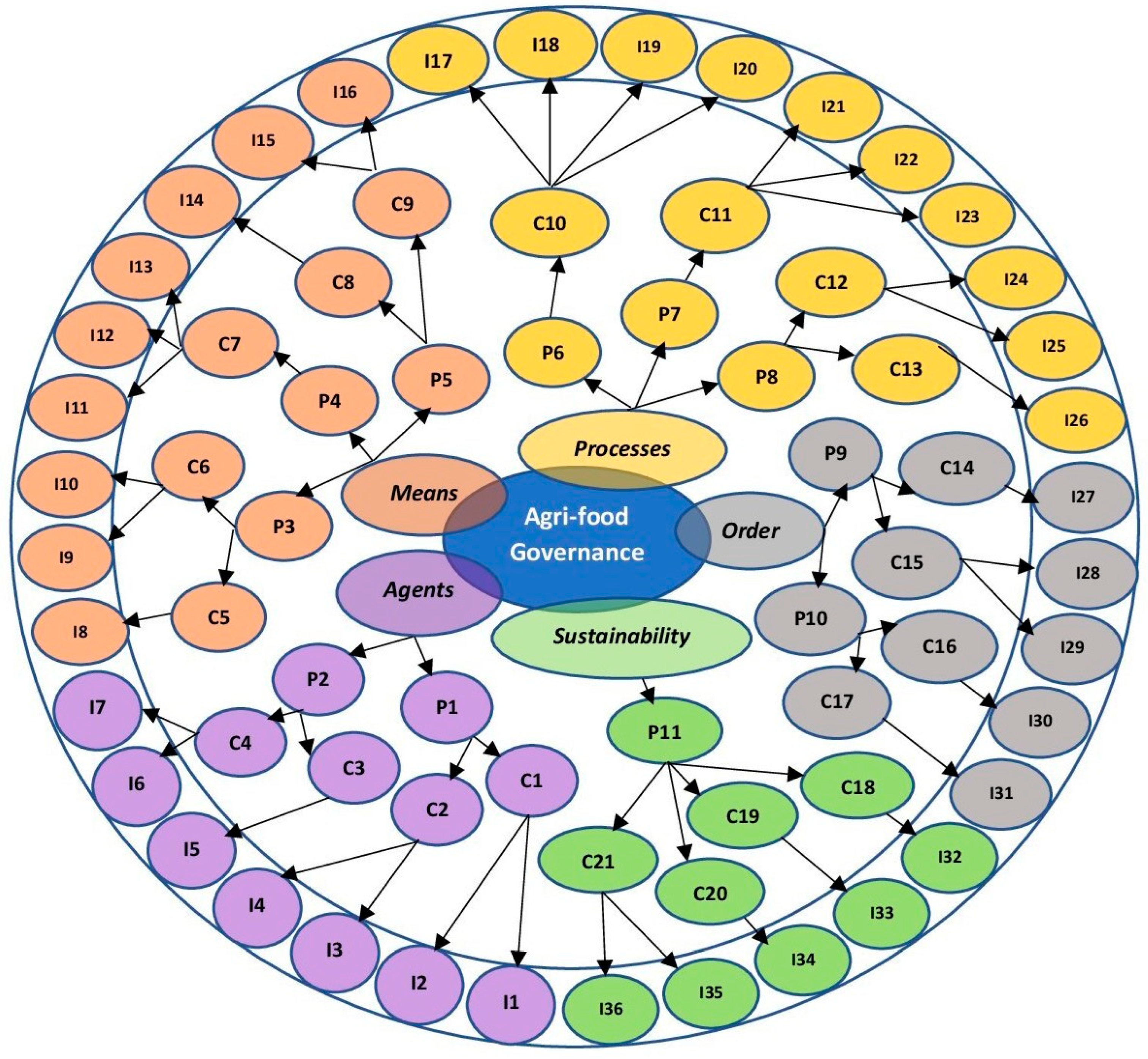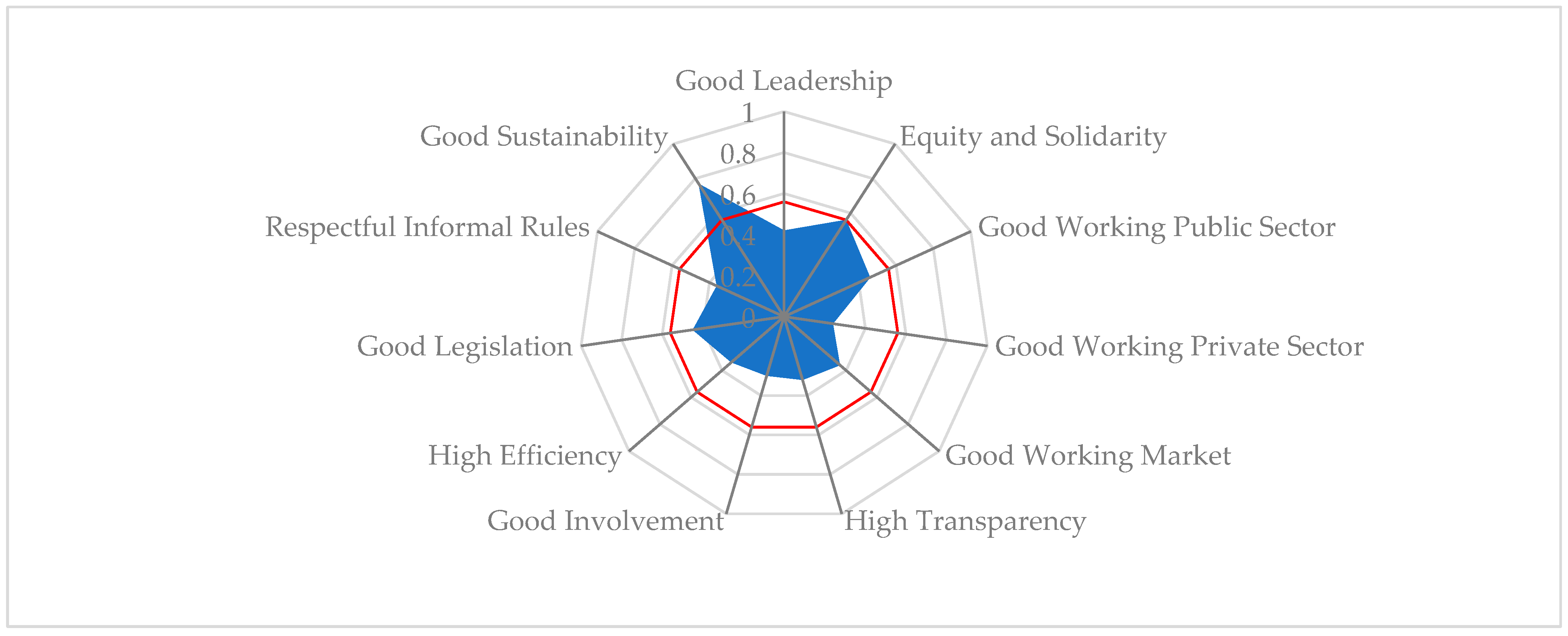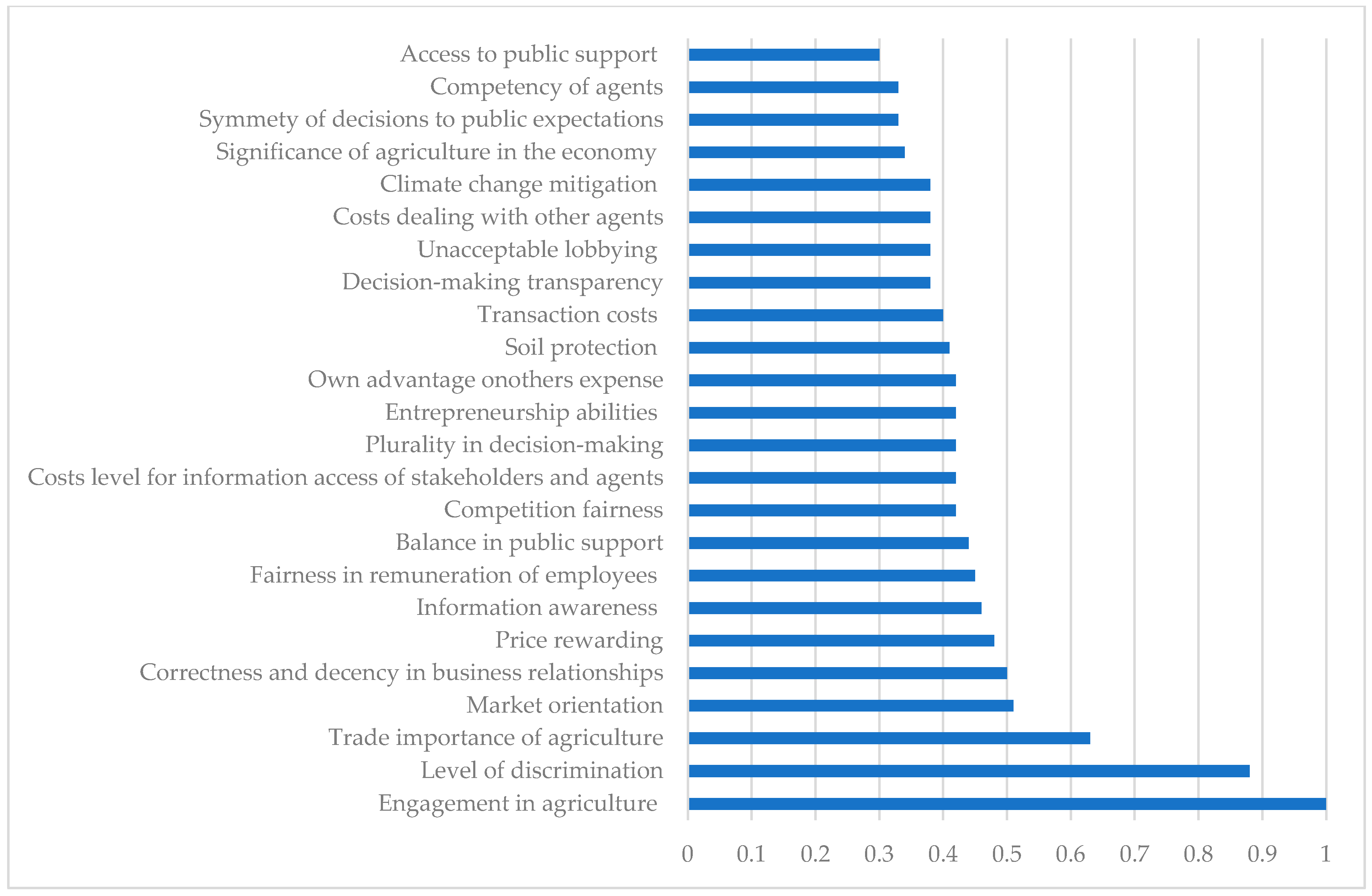Framework for a Holistic Assessment of the Quality of Agri-Food Governance in Bulgaria
Abstract
1. Introduction
2. Holistic Understanding of the System of Agri-Food Governance
3. Holistic Assessment of the Quality of the Agri-Food Governance System
- -
- defining the components of the agri-food governance system
- -
- formulating the principles of good quality agri-food governance
- -
- specifying the assessment criteria for each principle of agri-food governance
- -
- identifying the best indicators for measuring the quality of agri-food governance for each criterion
- -
- selecting the reference values for assessing the quality of agri-food governance for each indicator
- -
- deriving the agri-food governance quality score
- -
- determining the quality of agri-food governance
- -
- for agent component of governance: Good Leadership (P1) and Equity and Solidarity (P2)
- -
- for means component of governance: Good Working Public Sector (P3), Good Working Private Sector (P4), and Good Working Markets (P5)
- -
- for process component of governance: High Transparency (P6), Good Involvement (P7), and High Efficiency (P8)
- -
- for order component of governance: Good Legislation (P9) and Respectful Informal Rules (P10)
- -
- for sustainability component of governance: Good Sustainability (P11)
4. Quality of Governance of the Farming Component of Agri-Food Systems in Bulgaria
5. Conclusions
Author Contributions
Funding
Institutional Review Board Statement
Informed Consent Statement
Data Availability Statement
Conflicts of Interest
References
- Van Bers, C.; Delaney, A.; Eakin, H.; Cramer, L.; Purdon, M.; Oberlack, C.; Evans, T.; Pahl-Wostl, C.; Eriksen, S.; Jones, L.; et al. Advancing the research agenda on food systems governance and transformation. Curr. Opin. Environ. Sustain. 2019, 39, 94–102. [Google Scholar] [CrossRef]
- Canfield, M.; Duncan, J.; Claeys, P. Reconfiguring Food Systems Governance: The UNFSS and the Battle Over Authority and Legitimacy. Development 2021, 64, 181–191. [Google Scholar] [CrossRef] [PubMed]
- Cotula, L. Renegotiating Control in Global Food Governance. Agrar- & Ernährungspolitik April 2022. Available online: https://www.welthungerhilfe.de/welternaehrung/rubriken/agrar-ernaehrungspolitik/renegotiating-control-in-global-food-governance (accessed on 3 January 2024).
- Dring, C.; Newman, L.; Wittman, H. Assessing governability of agricultural systems: Municipal agricultural planning in Metro Vancouver, Canada. Front. Sustain. Food Syst. 2023, 6, 855684. [Google Scholar] [CrossRef]
- Dongyu, Q.; Ngcaba, N.; Mubarak, R. Building Sustainable Agrifood Systems: Legislation and Governance; UNEP: Nairobi, Kenya, 2022; Available online: https://www.unep.org/news-and-stories/speech/building-sustainable-agrifood-systems-legislation-and-governance (accessed on 3 January 2024).
- FAO. Governance for Agrifood Systems Transformation; FAO: Rome, Italy, 2023; Available online: https://www.fao.org/food-systems/news-events/news-detail/en/c/1645068/ (accessed on 3 January 2024).
- FMECD. Governance of Food Systems Transformation; FMECD: Bonn, Germany, 2023; Available online: https://assets.ctfassets.net/rrirl83ijfda/O69rtDmCXr7qZSA6wWHuw/8a9e5655a5598dbf0f6b25b85b04539a/Event_series_flyer_Online_version.pdf (accessed on 3 January 2024).
- Leeuwis, C.; Boogaard, B.; Atta-Krah, K. How food systems change (or not): Governance implications for system transformation processes. Food Secur. 2021, 13, 761–780. [Google Scholar] [CrossRef] [PubMed]
- Miranda, B.; Fowler Monteiro, G.; Rodrigues, V. Circular agri-food systems: A governance perspective for the analysis of sustainable agri-food value chains. Technol. Forecast. Soc. Change 2021, 170, 120878. [Google Scholar] [CrossRef]
- Shah, T.; Riemer, O. Transforming Agri-Food Systems via Inclusive, Rights-Based Governance; IISD: Al Safa, Saudi Arabia, 2023; Available online: https://sdg.iisd.org/commentary/guest-articles/transforming-agri-food-systems-via-inclusive-rights-based-governance/ (accessed on 3 January 2024).
- Termeera, C.; Drimie, S.; Ingram, J.; Pereira, L.; Whittingham, M. A diagnostic framework for food system governance arrangements: The case of South Africa. NJAS—Wagening. J. Life Sci. 2018, 84, 85–93. [Google Scholar] [CrossRef]
- UN. Governance of Food Systems Transformation, Policy Brief. In UN Food System Summit 2021; UN: San Francisco, CA, USA, 2021. [Google Scholar]
- Yap, C. New geographical directions for food systems governance research. Prog. Hum. Geogr. 2023, 47, 66–84. [Google Scholar] [CrossRef]
- Herrera, J. Rejecting the Social Contract: Criminal Governance, Agrarian Inequalities and the Autodefensa Movement in Michoacán, Mexico. J. Lat. Am. Stud. 2023, 55, 51–76. [Google Scholar] [CrossRef]
- Hospes, O.; Brons, A. Food System Governance; Systemic Literature Review; Routledge: London, UK, 2016. [Google Scholar]
- Gillespie, S.; Nisbett, N. Governance and Leadership in Agri-food Systems and Nutrition. In Agriculture for Improved Nutrition: Seizing the Momentum; Fan, S., Yosef, S., Pandya-Lorch, R., Eds.; CAB International: Wallingford, UK, 2019; pp. 122–133. [Google Scholar]
- Liljeblad, L.; Kennedy, A. Food Systems Governance, Routledge Studies in Food, Society and the Environment; Routledge: London, UK, 2018. [Google Scholar]
- Martínez, J.; Rivera, M. Territorial Governance and Social Innovation: The Cases of San Pedro Capula’s Artisanal Cheese and the Rice (Oryza sativa) of Morelos, Mexico. Agriculture 2018, 8, 23. [Google Scholar] [CrossRef]
- Terziev, D.; Zhou, P.; Terziyska, R.; Zhang, D. Food Safety: Technologies and Governance. In Yearbook of UNWE; UNWE: Sofia, Bulgaria, 2018; pp. 121–140. [Google Scholar]
- Torres-Salcido, G.; Sanz-Cañada, J. Territorial Governance. A Comparative Research of Local Agro-Food Systems in Mexico. Agriculture 2018, 8, 18. [Google Scholar] [CrossRef]
- Vignola, R.; Oosterveer, P.; Béné, C. Conceptualising Food System Governance and Its Present Challenges; Wageningen University: Wageningen, The Netherlands, 2021. [Google Scholar]
- Vinnari, E.; Vinnari, M. (Eds.) Sustainable Governance and Management of Food Systems. Ethical Perspectives; Wageningen Academic Publishers: Wageningen, The Netherlands, 2019. [Google Scholar]
- Chen, Q.; Knicke, K.; Tesfai, M.; Sumelius, J.; Turinawe, A.; Emegu Isoto, R.; Medyna, G. A Framework for Assessing Food System Governance in Six Urban and Peri-Urban Regions in Sub-saharan Africa. Front. Sustain. Food Syst. 2021, 30, 763352. [Google Scholar] [CrossRef]
- Bachev, H. Agrarian Governance—Who, What, Why, How, Where, When, Price, Level? Theor. Pract. Res. Econ. Fields 2023, 14, 105–125. [Google Scholar] [CrossRef]
- Delaney, A.; Evans, T.; McGreevy, J.; Blekking, J.; Schlachter, T.; Korhonen-Kurki, K.; Tamás, P.; Crane, T.; Eakin, H.; Förch, W.; et al. Governance of food systems across scales in times of social-ecological change: A review of indicators. Food Secur. 2018, 10, 287–310. [Google Scholar] [CrossRef]
- Oñederra-Aramendi, A.; Begiristain-Zubillaga, M.; Cuellar-Padilla, M. Characterisation of food governance for alternative and sustainable food systems: A systematic review. Agric. Food Econ. 2023, 11, 18. [Google Scholar] [CrossRef]
- Coase, R. The New Institutional Economics. Am. Econ. Rev. 1998, 88, 72–74. [Google Scholar]
- Furubotn, E.; Richter, R. Institutions and Economic Theory: The Contribution of the New Institutional Economics; The University of Michigan Press: Ann Arbor, MI, USA, 2005. [Google Scholar]
- North, D. Institutions. J. Econ. Perspect. 1991, 5, 97–112. [Google Scholar] [CrossRef]
- Williamson, O. The Economics of Governance. Am. Econ. Rev. 2005, 95, 1–18. [Google Scholar] [CrossRef]
- James, H.; Klein, P.; Sykuta, M. The Adoption, Diffusion, and Evolution of Organizational Form: Insights from the Agrifood Sector. Manag. Decis. Econ. 2011, 32, 243–259. [Google Scholar] [CrossRef]
- Sykuta, M. Concentration, Contracting and Competition: Problems in Using the Packers & Stockyards Act to Supplement Antitrust. CPI Antitrust J. 2010, 4, 1–7. [Google Scholar]
- Ali, M. Governance and Good Governance: A Conceptual Perspective. Dialogue 2015, 10, 67–77. [Google Scholar]
- Fukuyama, F. Governance: What Do We Know, and How Do We Know It? Annu. Rev. Political Sci. 2016, 19, 89–105. [Google Scholar] [CrossRef]
- Higgins, V.; Lawrence, G. Agricultural Governance: Globalization and the New Politics of Regulation; Routledge: London, UK, 2005. [Google Scholar]
- Scmitter, P. Defining, Explaining and, Then, Exploiting the Elusive Concept of ‘Governance’; Springer: Berlin/Heidelberg, Germany, 2018. [Google Scholar]
- Vymětal, P. Governance: Defining the Concept; Faculty of International Relations, University of Economics: Prague, Czech Republic, 2007; Working Papers, 1/2007. [Google Scholar]
- Ostrom, E. Beyond Markets and States: Polycentric Governance of Complex Economic Systems; Nobel Prize Lecture, 8 December 2009; American Economic Association: Nashville, TN, USA, 2009. [Google Scholar]
- Moragues-Faus, A.; Marsden, T. The political ecology of food: Carving ‘spaces of possibility’ in a new research agenda. J. Rural. Stud. 2017, 55, 275–288. [Google Scholar] [CrossRef]
- IoG. Principles for Good Governance in the 21st Century; Institute of Governance: Ottawa, ON, Canada, 2023. [Google Scholar]
- Planas, J.; Schuurman, A.; Segers, Y. The Formation of Agricultural Governance: The Interplay between State and Civil Society in European Agriculture, 1870–1940; WASSRural and Environmental History; Sociedad de Estudios de Historia Agraria: Murcia, Spain, 2022. [Google Scholar]
- Wolman, H.; Levy, A.; Hincapie, D. Government and Governance. In Economic Competitiveness and the Determinants of Sub-National Area Economic Activity; Office of the Chief Financial Officer of the District of Columbia, Office of Revenue Analysis: Washington DC, USA, 2008. [Google Scholar]
- World Bank. Worldwide Governance Indicators. 2022. Available online: https://info.worldbank.org/governance/wgi/Home/Reports (accessed on 3 January 2024).
- Bachev, H. Governance of Agrarian Sustainability; Nova Science Publishers: New York, NY, USA, 2010. [Google Scholar]
- Dixit, A. Economic Governance. The New Palgrave Dictionary of Economics; Springer: Berlin/Heidelberg, Germany, 2016; pp. 1–11. [Google Scholar]
- Georgiev, M. Impact of the Administration Structure and Transaction Costs on the Agricultural Land Market. Trakia J. Sci. 2013, 11, 527–534. [Google Scholar]
- Osabohien, R.; Ufua, D.; Moses, C.L.; Osabuohien, E. Accountability in agricultural governance and food security in Nigeria. Braz. J. Food Technol. 2020, 23. [Google Scholar] [CrossRef]
- Ronaghi, M.; Ronaghi, M.; Kohansal, M. Agricultural Governance; Verlag GlobeEdit: Riga, Latvia, 2020. [Google Scholar]
- EU. European Governance, EU. 2019. Available online: https://eur-lex.europa.eu/summary/glossary/governance.html (accessed on 3 January 2024).
- UN. The Sustainable Development Goals (SDGs); United Nations: San Francisco, CA, USA, 2015. [Google Scholar]
- Bayyurt, N.; Arıkan, F.E. Good Governance and Agricultural Efficiency. J. Soc. Dev. Sci. 2015, 6, 14–23. [Google Scholar] [CrossRef]
- DFID. The Limits of Decentralized Governance: The Case of Agriculture in Malawi; DFID: London, UK, 2010; Policy Brief 033, 2010.
- OECD. G20/OECD Principles of Corporate Governance; OECD Publishing: Paris, France, 2015. [Google Scholar]
- Weiss, T. Governance, good governance and global governance: Conceptual and actual challenges. Third World Q. 2000, 21, 795–814. [Google Scholar] [CrossRef]
- Katsamunska, P. Good Governance and Reform of Public Administration in Bulgaria. Econ. Altern. 2010, 1, 52–60. [Google Scholar]
- European Commission. Public Administration and Governance: Bulgaria; European Commission: Brussels, Belgium, 2021. [Google Scholar]
- Cigna, G.; Djuric, P.; Kobel, Y.; Sigheartau, A. Corporate Governance in Transition Economies Bulgaria; Country Report; EBRD: London, UK, 2017. [Google Scholar]
- Ivanov, B.; Bachev, H. How Good is the Governance of Bulgarian Agriculture? Econ. Altern. 2024, 2. (under publication). [Google Scholar]
- Agrarian paper. Agrarian Paper—2023; MAF: Sofia, Bulgaria, 2023. [Google Scholar]
- Boevsky, I.; Sarov, A. Cooperative Governance-Challenges and Perspectives. In Proceedings of the Scientific Forum the XXI Century Business-Trends and Challenges, Sofia, Bulgaria, 26 May 2016; UNSS: Sofia, Bulgaria, 2017; pp. 366–377, ISBN 978-954-644-937-5. [Google Scholar]
- Krustev, V. Assessment of the EU market farms sustainability based on a composite sustainability index. Bulg. J. Agric. Sci. 2023, 29, 597–604. [Google Scholar]





| Components | Principles | Criteria | Indicators | Description of Indicators | Estimation | Units |
|---|---|---|---|---|---|---|
| Agents | Good leadership (P1) | Goodwill (C1) | Taking advantage at others’ expense (I1) | Level of achieving own advantage at the expense of others through legal and illegal means | Expert assessment | Ranking score |
| Correctness and decency in business relationships (I2) | Correctness and decency in business relationships in agriculture | Expert assessment | Ranking score | |||
| High competency (C2) | Competency of agents (I3) | Degree of competency and expertise of agrarian agents | Expert assessment | Ranking score | ||
| Entrepreneurship abilities (I4) | Agents’ entrepreneurship abilities and self-improvement | Expert assessment | Ranking score | |||
| Equity and solidarity (P2) | Gender equity (C3) | Level of discrimination (I5) | Level of discrimination on ethnical, religious and bigotry causes | Expert assessment | Ranking score | |
| Fair distribution (C4) | Fairness in remuneration of employees (I6) | Compensation of employees in agriculture/factor income | RCA method | Share | ||
| Balance in public support (I7) | Gini coefficient | RCA method | Coefficient | |||
| Means | Good Working Public Sector (P3) | No administrative deadweight (C5) | Unlawful payments (I8) | Level of unlawful payments and embezzlement | Expert assessment | Ranking score |
| Supportive administration (C6) | Satisfaction from administrative services (I9) | Satisfaction degree from administrative services | Expert assessment | Ranking score | ||
| Public spending for agrarian administration (I10) | Agri-governmental expenditure unto total governmental spending | RCA method | Percent | |||
| Good Working Private Sector (P4) | Efficient private sector (C7) | Effectiveness of agrarian contracting (I11) | Effectiveness of contracting among agents in agriculture | Experts assessment | Ranking score | |
| Opportunities for different organizations (I12) | Equality in opportunities for the development of different organizational forms | Experts assessment | Rankingscore | |||
| External contracting (I13) | Contractual work for the total output of farms | RCA method | Ranking score | |||
| Good Working Market (P5) | Accessible market (C8) | Market entry and exit costs (I14) | Level of entry and exit market costs | Expert assessment | Ranking score | |
| Fair competition (C9) | Competition fairness (I15) | Competition fairness and avoiding price rigging | Expert assessment | Ranking score | ||
| Market orientation (I16) | Farm use and farm households’ consumption unto total output | RCA method | Share | |||
| Processes | High transparency (P6) | Confident level of awareness (C10) | Information awareness (I17) | Information awareness of agrarian agents and stakeholders | Expert assessment | Ranking score |
| Costs for information access (I18) | Cost level for information access of stakeholders and agents | Expert assessment | Ranking score | |||
| Decision-making transparency (I19) | Decision-making transparency extent | Expert assessment | Ranking score | |||
| Symmetry of decisions to public expectations (I20) | Symmetry between decisions made and public expectations in agriculture | Expert assessment | Ranking score | |||
| Good involvement (P7) | Participatory decision-making (C11) | Plurality in decision-making (I21) | Plurality level in the decision-making process in agriculture | Experts assessment | Ranking score | |
| Unacceptable lobbying (I22) | Level of unacceptable lobbying impairing third parties | Expert assessment | Ranking score | |||
| Access to public support (I23) | Share of farms with direct payment in the total number of farms | RCA method | Percent | |||
| High efficiency (P8) | High return (C12) | Costs for dealing with other agents (I24) | Total efforts and costs for dealing with other private and public agents in agriculture | Expert assessment | Ranking score | |
| Price rewarding potential (I25) | Price index outputs/price input index | RCA method | Index | |||
| Low transaction costs (C13) | Transaction costs (I26) | Total farm overhead costs/total input | RCA method | Share | ||
| Order | Good legislation (P9) | Comprehensive legislation (C14) | Completeness of legislation (I27) | Completeness of legislation | Expert assessment | Ranking score |
| Justified enforcement (C15) | Implementation and compliance with legislation (I28) | Degree of implementation and conformity with legislation | Expert assessment | Ranking score | ||
| Costs for study and enforcement rules (I29) | Level of regulation costs for acquaintance and enforcement | Expert assessment | Ranking score | |||
| Respectful informal rules (P10) | Mutual trust (C16) | Trust in agriculture (I30) | Level of trust between agrarian subjects | Expert assessment | Ranking score | |
| Good manner (C17) | Conflicts in community (I31) | Conflict level and contradiction state within agricultural communities | Expert assessment | Ranking score | ||
| Sustainability | Good sustainability (P11) | Stable employment (C18) | Engagement in agriculture (I32) | Share of the population employed in agriculture | RCA method | Percent |
| High GAV (C19) | Economic significance of agriculture (I33) | GAV of agriculture per capita | RCA method | Euro | ||
| Competitive trade (C20) | Trade importance of agriculture (I34) | Agricultural export/agricultural import | RCA method | Index | ||
| Resilient environment (C21) | Climate change mitigation (I35) | State of greenhouse gases from agriculture in total greenhouse gases in the country | RCA method | Percent | ||
| Soil protection (I36) | Quantity of nitrogen fertilizer use | RCA method | Kg/ha |
Disclaimer/Publisher’s Note: The statements, opinions and data contained in all publications are solely those of the individual author(s) and contributor(s) and not of MDPI and/or the editor(s). MDPI and/or the editor(s) disclaim responsibility for any injury to people or property resulting from any ideas, methods, instructions or products referred to in the content. |
© 2024 by the authors. Licensee MDPI, Basel, Switzerland. This article is an open access article distributed under the terms and conditions of the Creative Commons Attribution (CC BY) license (https://creativecommons.org/licenses/by/4.0/).
Share and Cite
Bachev, H.; Ivanov, B. Framework for a Holistic Assessment of the Quality of Agri-Food Governance in Bulgaria. Sustainability 2024, 16, 2177. https://doi.org/10.3390/su16052177
Bachev H, Ivanov B. Framework for a Holistic Assessment of the Quality of Agri-Food Governance in Bulgaria. Sustainability. 2024; 16(5):2177. https://doi.org/10.3390/su16052177
Chicago/Turabian StyleBachev, Hrabrin, and Bozhidar Ivanov. 2024. "Framework for a Holistic Assessment of the Quality of Agri-Food Governance in Bulgaria" Sustainability 16, no. 5: 2177. https://doi.org/10.3390/su16052177
APA StyleBachev, H., & Ivanov, B. (2024). Framework for a Holistic Assessment of the Quality of Agri-Food Governance in Bulgaria. Sustainability, 16(5), 2177. https://doi.org/10.3390/su16052177







